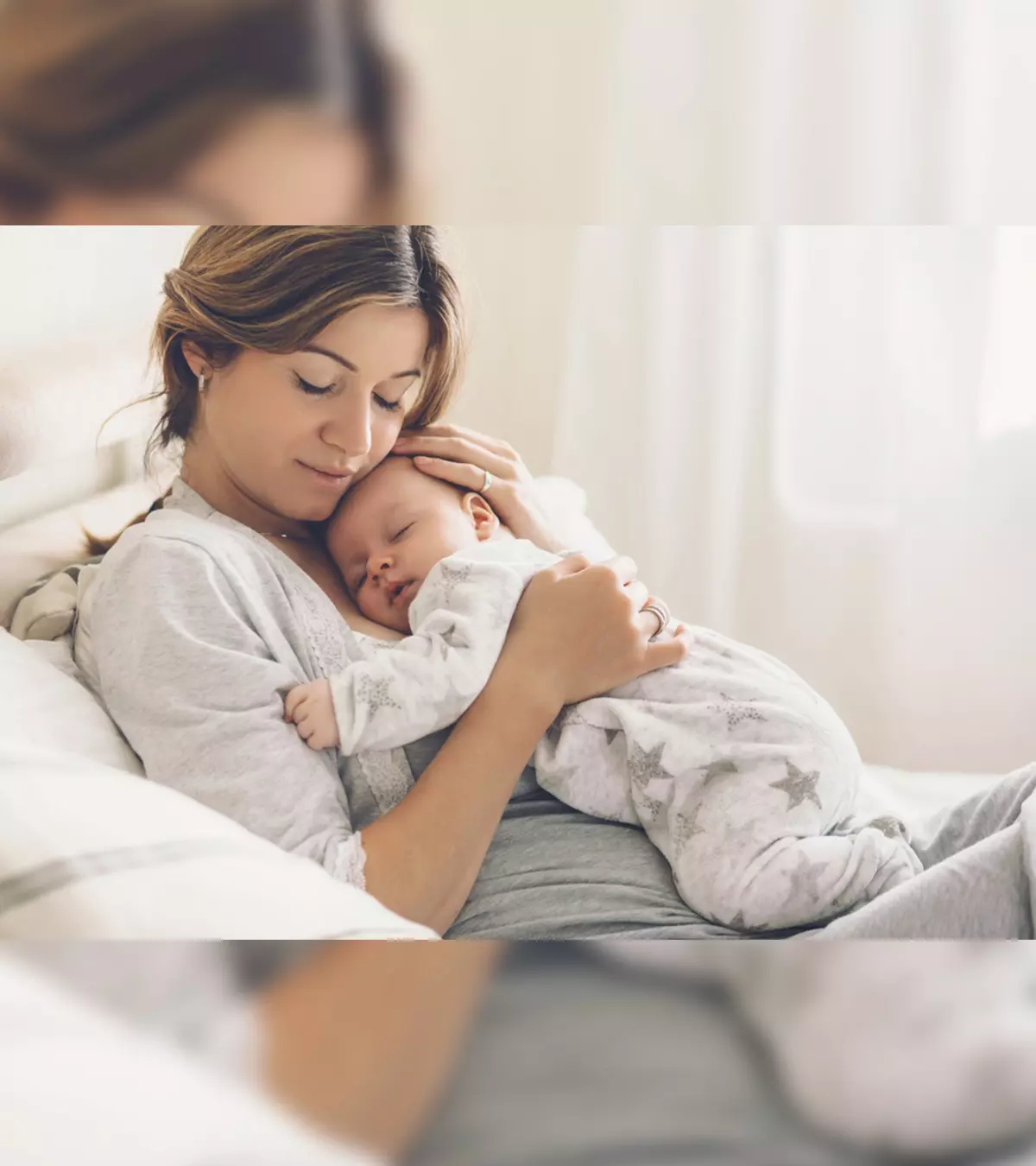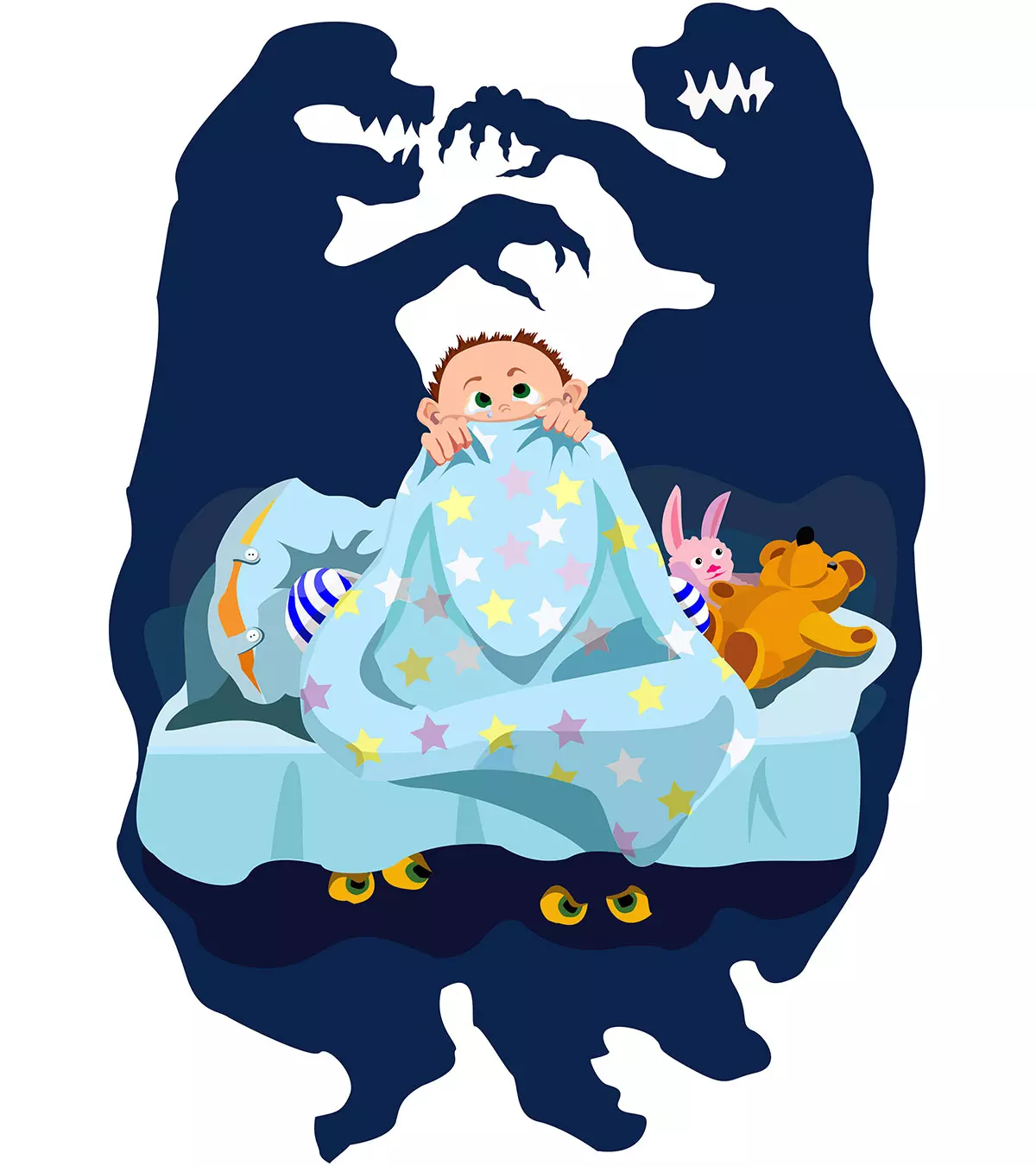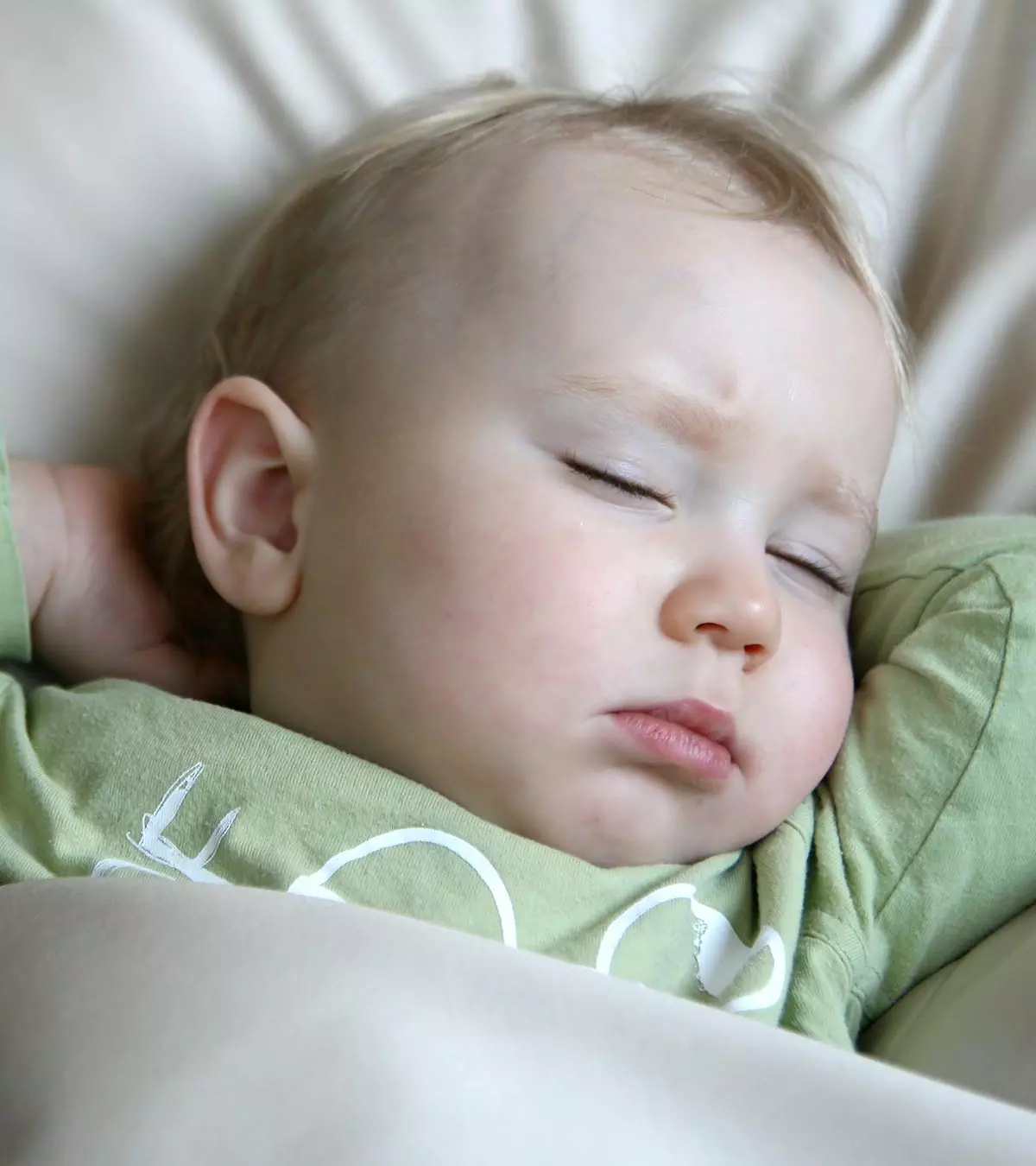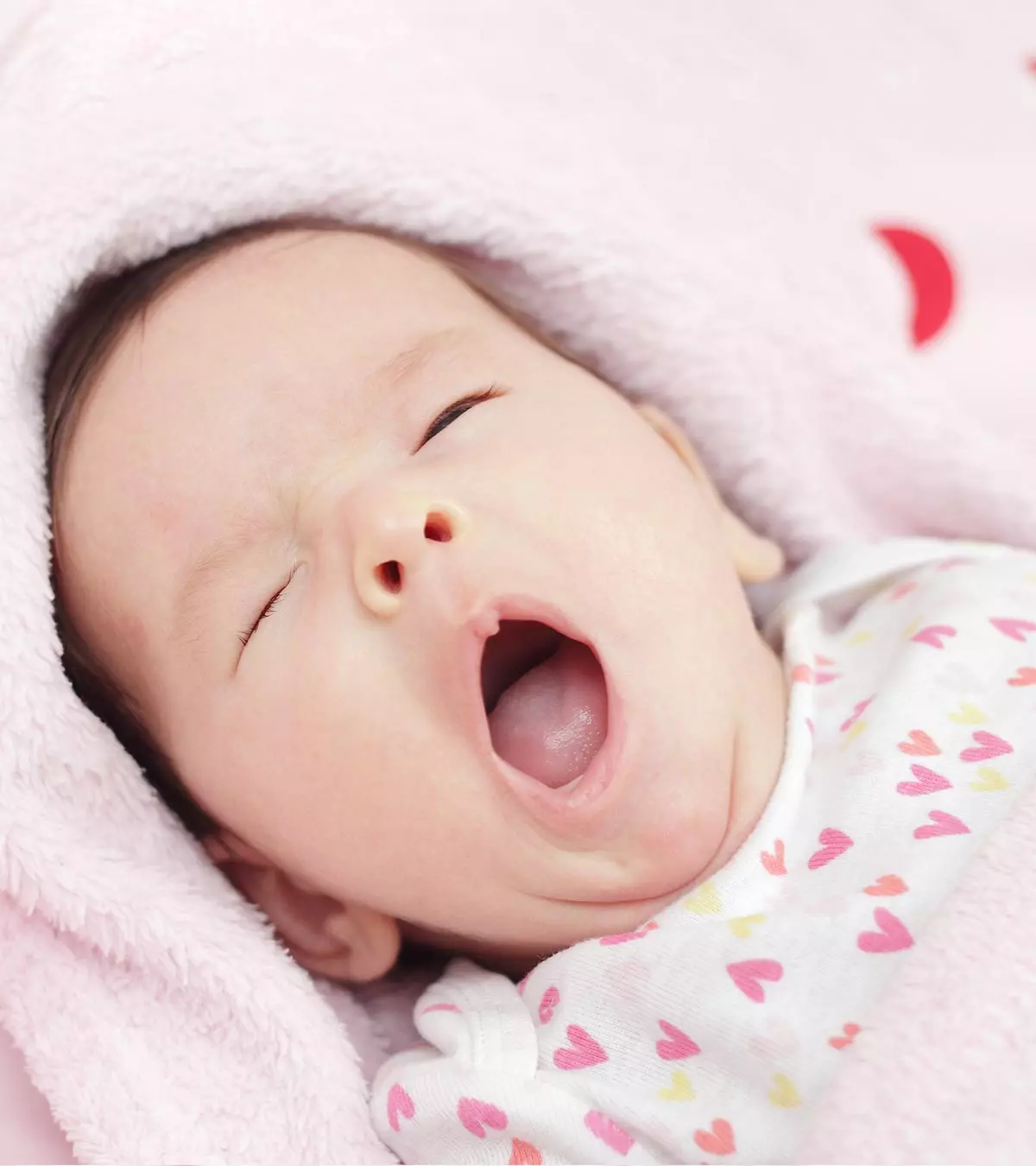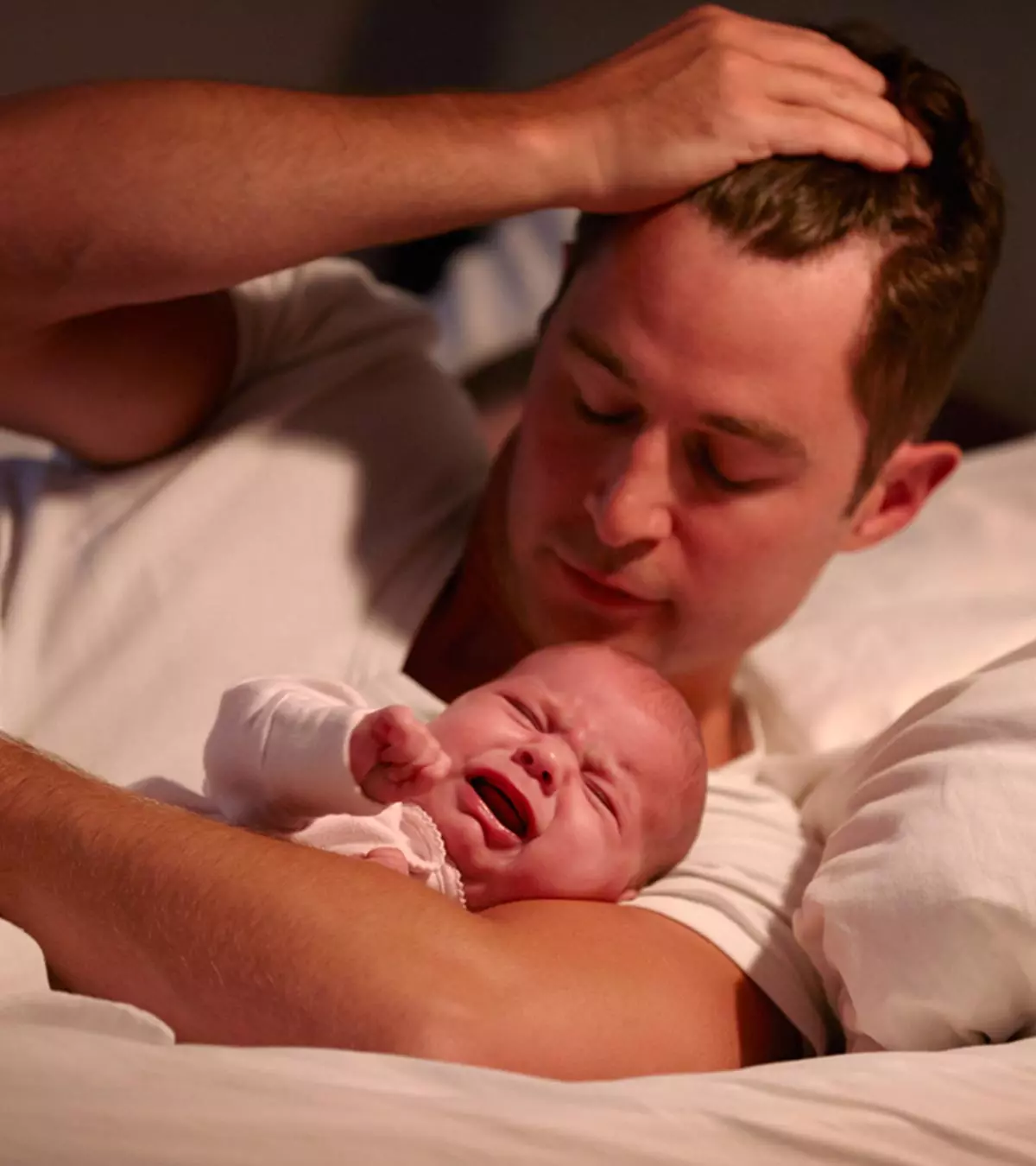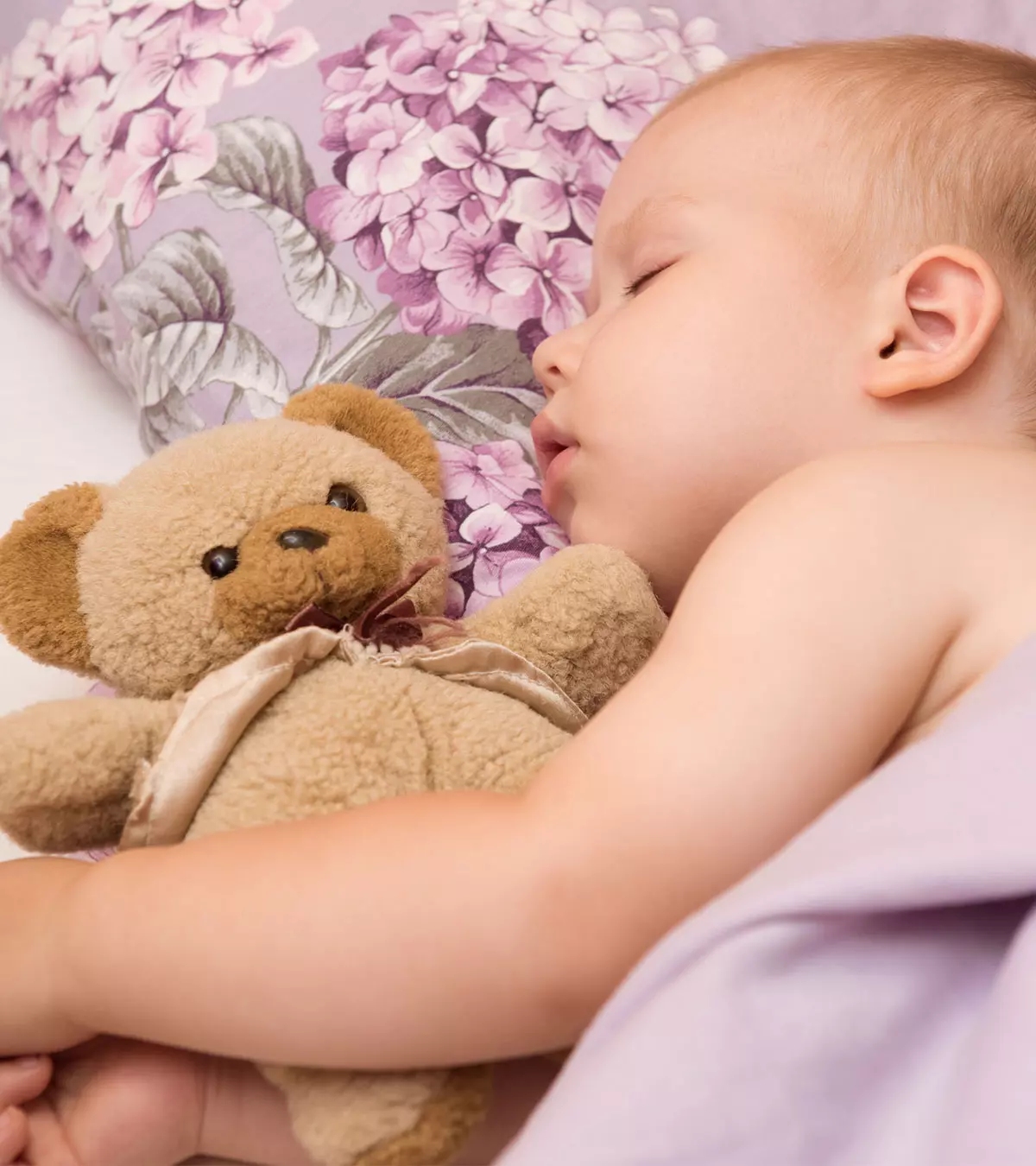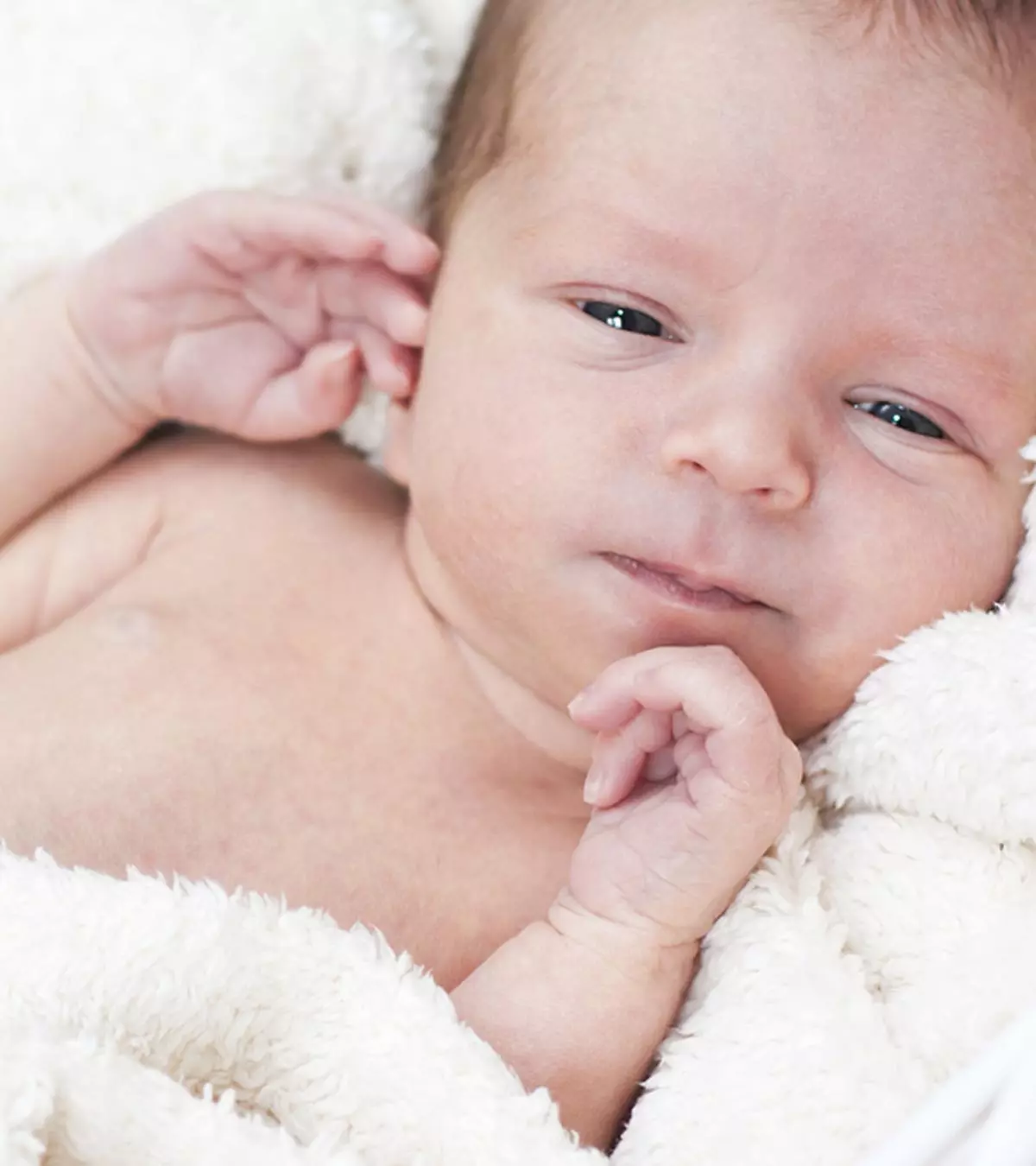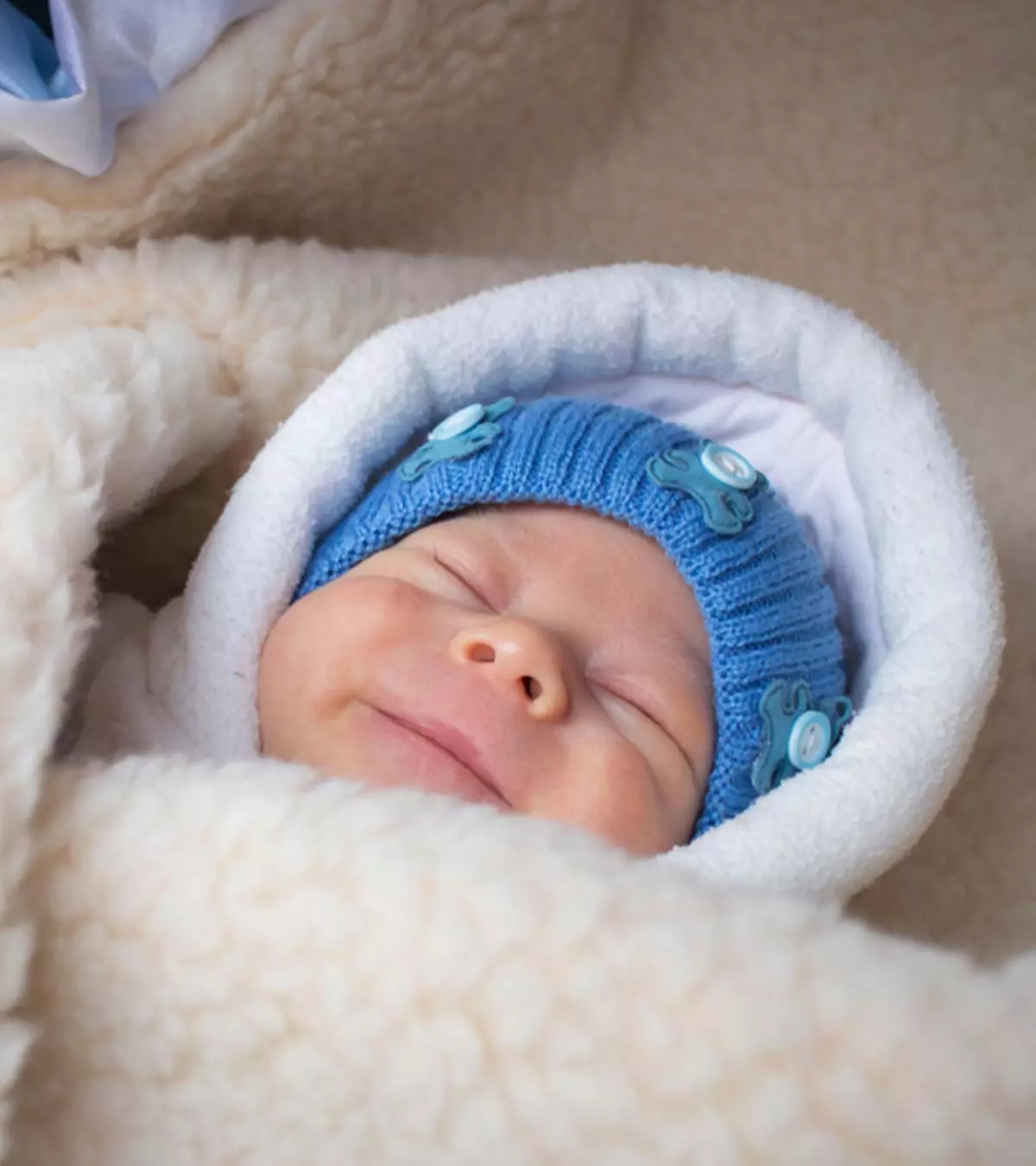
Image: Shutterstock
Although it may sound like a basic question, many parents may think about how to dress babies for sleep to ensure they and their baby can have a good night’s sleep. A baby can sleep well in a safe and comfortable sleep environment that is neither too hot nor too cold. The baby’s bedtime attire is important to create the desired comfort.

Want to know what kind of dressing is ideal for bedtime? Read the post to get all the important tips about dressing your baby to sleep.
Key Pointers
- Finding weather-appropriate clothes to dress your baby for sleep is essential to keep them safe and comfortable.
- According to experts, parents should select a dress as per the room or nursery temperature. The ideal room temperature for babies is up to 69℉ (20.5℃).
- Avoid excessive dressing to prevent overheating. Overheating at night may increase the risk of SIDS.
- Monitor your baby and look for the signs, like red face or too warm or cold tummy/back, indicating that the baby isn’t comfortable in its nightwear.
What Should A Baby Wear To Sleep?
The thumb rule is to dress your baby according to the room temperature
. The baby nightwear or dress in which the infant feels comfortable and safe is considered the right choice. Experts recommend adding one layer to the dress your baby finds comfortable wearing. Here are a few basic rules for dressing your little one (1), (2), (3), (4).
- Prefer layers: Consider dressing your baby in layers of comfortable clothing rather than one thick pajama. It is advisable to add or reduce the layers as the ambient temperature changes.
- Avoid beanies or headgear: Babies can overheat pretty quickly when they sleep wearing beanies or headgear. It can also be a suffocation hazard. Therefore, keep their head and face uncovered when sleeping. If you notice your baby sweating in sleep, remove a layer of clothing.
- Avoid loose clothes around the neck: Never put the baby to sleep in nightgowns that are loose around the neck as these can cause choking or suffocation. A one-piece with built-in feet is a good option.
- Opt for a safe sleeping bag: An appropriately sized sleeping bag is an ideal choice to keep your baby’s head and face uncovered while sleeping. These bags can help avoid overheating, rolling on the stomach, and hanging of legs outside of the cot. You could also choose sleep sacks that are without a hood and are fitted around the neck; these facilitate arm movement and do not allow the baby to slip inside. Depending on the TOG (thermal overall grade), you may choose a sleeping bag for different temperatures.
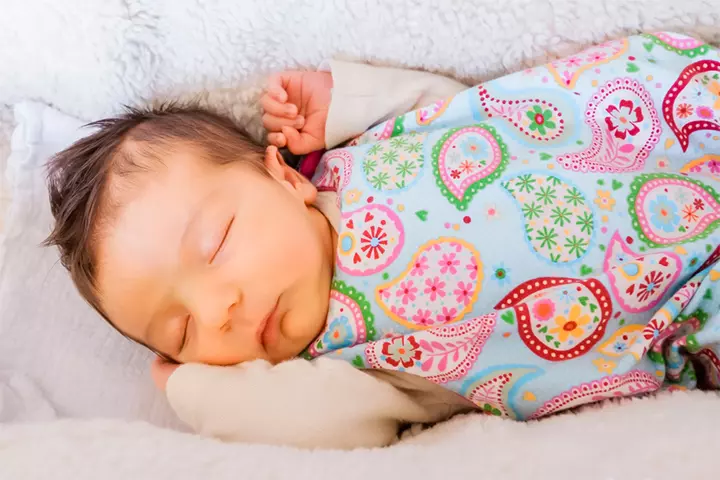
 Point to consider
Point to consider- Use breathable fabrics: Put younger babies in a breathable, lightweight fabric, such as cotton or muslin, when swaddling or wrapping. Avoid wrapping babies as soon as they start showing signs of rolling over. If you plan to use blankets or sheets, make sure they are also breathable and lightweight.
A mom and blogger, Anna Western, stresses the importance of selecting weather-appropriate baby clothes. She explains, “I think the most important thing about baby clothes is how they relate to sleep. You really don’t want your baby to overheat or be too cold while sleeping, so deciding what they should wear to sleep is important. We found that when she (Anna’s daughter) was being swaddled in the muslin blankets, she needed a cotton onesie with feet and long sleeves. And when we started swaddling her in the Halo, we switched to a short-sleeved onesie without legs because that swaddle is warm and holds more heat (i).”
Ideal Sleeping Temperature For Babies
Babies are highly susceptible to changes in temperature because their bodies are small and still undergoing development. Researchers believe that by the time babies are 11 weeks old, they reach their minimum core body temperature (97.5℉ or 36.4℃) like adults within four hours of bedtime (5). Here are a few things you need to know about the ideal sleeping temperature for babies (3), (4), (5).
Baby’s temperature
- Babies regulate their body temperature through the head and face.
- You might feel that your baby’s feet and hands are cool, but this isn’t the best indication of their temperature. You may figure out your baby’s temperature by touching your baby’s stomach, back, or back of the neck.
Room temperature

- The ideal room temperature for babies is up to 69℉ or 20.5℃.
- A room that is too warm or hot can increase the risk of sudden infant death syndrome (SIDS). The Centers for Disease Control and Prevention highlights that the incidence rate of SIDS in the United States is 41%.
It is important to ensure that your baby sleeps on the back, is not underdressed or overdressed for the room. Dress them according to the room temperature, and keep their face and head uncovered. If you notice your baby sweating in sleep, remove a layer of clothing.
 Quick fact
Quick factHow To Dress A Baby For Sleep In The Summer?

While dressing your baby in summers, consider the following (2, 3, 4):
- When it gets toastier, make sure you dress the baby such that their skin doesn’t feel hot or sticky.
- Use lightweight, breathable natural fabrics (cotton or muslin).
- Dress them in sleeveless or legless onesies or in a diaper and a singlet.
- If your baby’s room is too hot, you may use a ceiling or floor fan to control the temperature. It is advised to keep the plug-in of the fan away from the baby, preferably on the opposite side of the room.
- If the baby fusses, even after all their needs are met, check their clothing to rule out any discomfort.
Keep an eye on signs that your baby is overheating, which can include sweating, flushed skin, or rapid breathing. If you notice these signs, promptly remove a layer of clothing to help regulate their temperature.
How To Dress A Baby For Sleep In The Winter?
- While dressing your baby in winters, consider the following (2, 3, 4):
- Adding layers is the way to go in winters to keep your baby comfortable.
- Avoid using beanies or headgear (hats) while sleeping, as it may cause overheating. Also, you may remove extra clothing if indoors or in a warm vehicle.
- A full suit can keep your baby warm and comfortable.
- You may use sheets and blankets that are lightweight and breathable.
 Did you know?
Did you know?- If the room is too cold, use a room heater for a comfortable temperature to combat low temperature in babies. Maintain humidity in the room. Do not use electric blankets or hot water bottles. Also, keep the door slightly open to avoid overheating.
- A sleep sack is another good option to keep them cozy and warm. Sleep sacks of 2 tog are preferred for the winter and fall months.
Always be vigilant about signs of discomfort, such as excessive fussiness or temperature fluctuations in your baby. If your baby appears restless or wakes frequently, it may be necessary to adjust their clothing layers to better suit their comfort needs.
Dressing Babies For Sleep In A 70-Degree Room
When your baby sleeps in a 70℉ room, you may use a sleep sack of 1 tog, a long sleeve pajama, and a onesie. For younger babies, you can use a lightweight swaddle (2).
Dressing Babies At Different Temperatures
Based on the different room or nursery temperatures, dress your baby in the following ways during sleep (2).
- Less than 16℃/60℉: Long sleeve pajama, mittens, socks, long sleeve onesie, and light sleep sack (2 tog)
- 16—17℃/61—63℉: Long sleeve pajama, long sleeve onesie, light sleep sack (2 togs), and socks
- 18—19℃/64—68℉: Long sleeve pajama, long sleeve onesie, and light sleep sack (1 tog)
- 20—21℃/69—70℉: Long sleeve pajama, onesie, and light sleep sack (1 tog)
- 22—23℃/71—74℉: Long sleeve pajama and light sleep sack (0.5 tog)
- 24—25℃/75—77℉: Light sleep sack (0.5 tog) and onesie
- 26℃/78℉: Onesie
- 27℃/80℉: A diaper or nappy alone would suffice

Moreover, consider keeping a digital thermometer for accuracy, adjusting clothing based on the baby’s activity level, and using air conditioning or heating as necessary.
How To Keep A Baby Warm At Night?
Overheating at night may increase the risk of SIDS. Therefore, it is important not to overdress the baby. Here are a few tips that you can follow.
- As a general rule, dress your baby in clothes that can be easily removed when there is a change in temperature or a need for a diaper change.
- Avoid any loose blankets, quilts, pillows, or soft toys that can be a suffocation hazard.
- Add one extra layer to what you are comfortable wearing in a particular environment.
- Choose safe sleep sacks or wearable blankets of natural, breathable material over blankets.
- Swaddling in a lightweight, breathable material can give your baby extra warmth. However, stop this once your baby shows signs of rolling over — this usually happens at two to four months.
According to Dr. Zeeshan Afzal, specialty registrar from Cambridge, UK, “Swaddling can be helpful for newborns who have not yet developed strong motor control and startle reflexes, but it may not be required for all babies. If your baby dislikes swaddling, you can try using a sleep sack or wearable blanket to provide a cozy and secure sleeping environment. You can also try soothing techniques like white noise, gentle rocking, or a pacifier.”

- In freezing climates, it is advisable to invest in thermal curtains and external doors.
- In case you opt for blankets, make sure they are lightweight, breathable, and small so that they do not cause choking or get tangled around the baby. The material can include cotton, hemp, cashmere, linen, silk, or wool.
Frequently Asked Questions
1. How should I wrap my baby when sleeping?
You may wrap the baby by gently tucking their arms next to their body and swaddling them in lightweight, breathable fabric. You may also keep their arms out. Ensure the wrap is not too tight and allows for some movement. The wrap must never cover the baby’s face and head. Do not wrap them once they start showing signs of rolling over.
2. How do I know if the baby is cold at night?
Babies lose heat through their head and face. Often, parents touch their baby’s feet and hands to determine the baby’s temperature. However, it is not the right indication of your baby’s temperature. Feel their tummy, back, or back of the neck to check if they are warm.
3. What should I do if my baby wakes up sweating?
If your baby wakes up sweating, it’s usually not a cause for alarm, but you should check the room’s temperature and ensure it’s comfortably cool. Dress your baby in lightweight, breathable clothing and avoid heavy blankets. Sweating can also occur during active sleep or due to mild illness like a fever, so monitor for other symptoms. If excessive sweating persists or is accompanied by difficulty breathing, weight loss, or irritability, consult your pediatrician to rule out underlying conditions like sleep apnea or infections.
4. How do I know if the baby is comfortable?
Check for prominent signs of discomfort, such as a red face and fussing/crying. Other notable signs of an uncomfortable baby include waking up frequently, having a tight or stiff body, arching the back, and flailing arms and legs. The baby may also seem too warm or cold to touch.
5. Can babies overheat in a swaddle?
According to the American Academy of Pediatrics, “swaddling can increase the chance your baby will overheat, so avoid letting your baby get too hot. The baby could be too hot if you notice sweating, damp hair, flushed cheeks, heat rash, and rapid breathing (6).”
6. Should babies sleep in footless pajamas?
Babies can sleep in footless pajamas comfortably. However, you can swaddle the baby or put them in a sleep sack if you feel the weather is cold and your baby may need to cover their feet.
7. How do I keep my baby warm at night without a blanket?
Dress your baby in layers so you may remove or add a layer as per need. Use footed sleeper pajamas, infant bodysuits, or onesies to keep your baby’s feet warm. Ensure adequate layers to keep the baby warm without overheating. Wearable blankets and sleeping sacks are safe alternatives to blankets.
Knowing how to dress babies for sleep helps parents and caregivers sleep for longer since an appropriately dressed baby also has an undisturbed sleep. Dress your baby according to the room temperature and maintain the same room temperature throughout the night. Further, it is best to dress them in layers rather than one layer of thick cloth. You may then remove a layer according to the room temperature. Also, choose clothes made of breathable materials and avoid loose clothing around the neck since they may choke the baby.
Infographic: Things To Consider While Buying Sleepwear For Babies
Your baby should be comfortable in their sleepwear, making it essential to pick the right clothing for their sound sleep. Before buying one, give this infographic a read to know what you should be looking for in ideal baby sleepwear.
Some thing wrong with infographic shortcode. please verify shortcode syntax
Illustration: How To Dress Babies For Sleep (At Different Temperatures)?
_illustration.jpg.webp)
Image: Stable Diffusion/MomJunction Design Team
Learn how to swaddle your baby like a pro! Follow along in this video as a medical expert shows you the proper technique for keeping your little one safe and secure.
Personal Experience: Source
MomJunction articles include first-hand experiences to provide you with better insights through real-life narratives. Here are the sources of personal accounts referenced in this article.
i. Preparing for Baby: How to Survive the First 3 Months or What I Wish I Had Known Before Going Into Labor 3 Weeks Early!;https://annawestern.medium.com/preparing-for-baby-how-to-survive-the-first-3-months-or-what-i-wish-i-had-known-before-going-into-a427c6f5c8f4
References
1. What babies should wear to sleep?; National Sleep Foundation
2. How To Dress Your Baby For Sleeping In 70 Degree Room?; Sleep Advisor
3. Dressing babies for bed: Raising Children Network (Australia)
4. How to dress baby for sleep: Red Nose Australia
5. The best temperature for sleep: SleepFoundation.org
6. Swaddling: Is it Safe for Your Baby?; American Academy Of Pediatrics
7. The Lullaby Trust Safer Sleep Advice For Premature Babies; Lullaby Trust
8. How To Dress Your Child for Sleep; Sleep Foundation
9. Safe sleep for babies; Pregnancy Birth And Baby
Community Experiences
Join the conversation and become a part of our nurturing community! Share your stories, experiences, and insights to connect with fellow parents.
Read full bio of Jennifer Renee Chu
Read full bio of Dr. Ritika Shah
Read full bio of Rohit Garoo
Read full bio of Ghazia Shah





